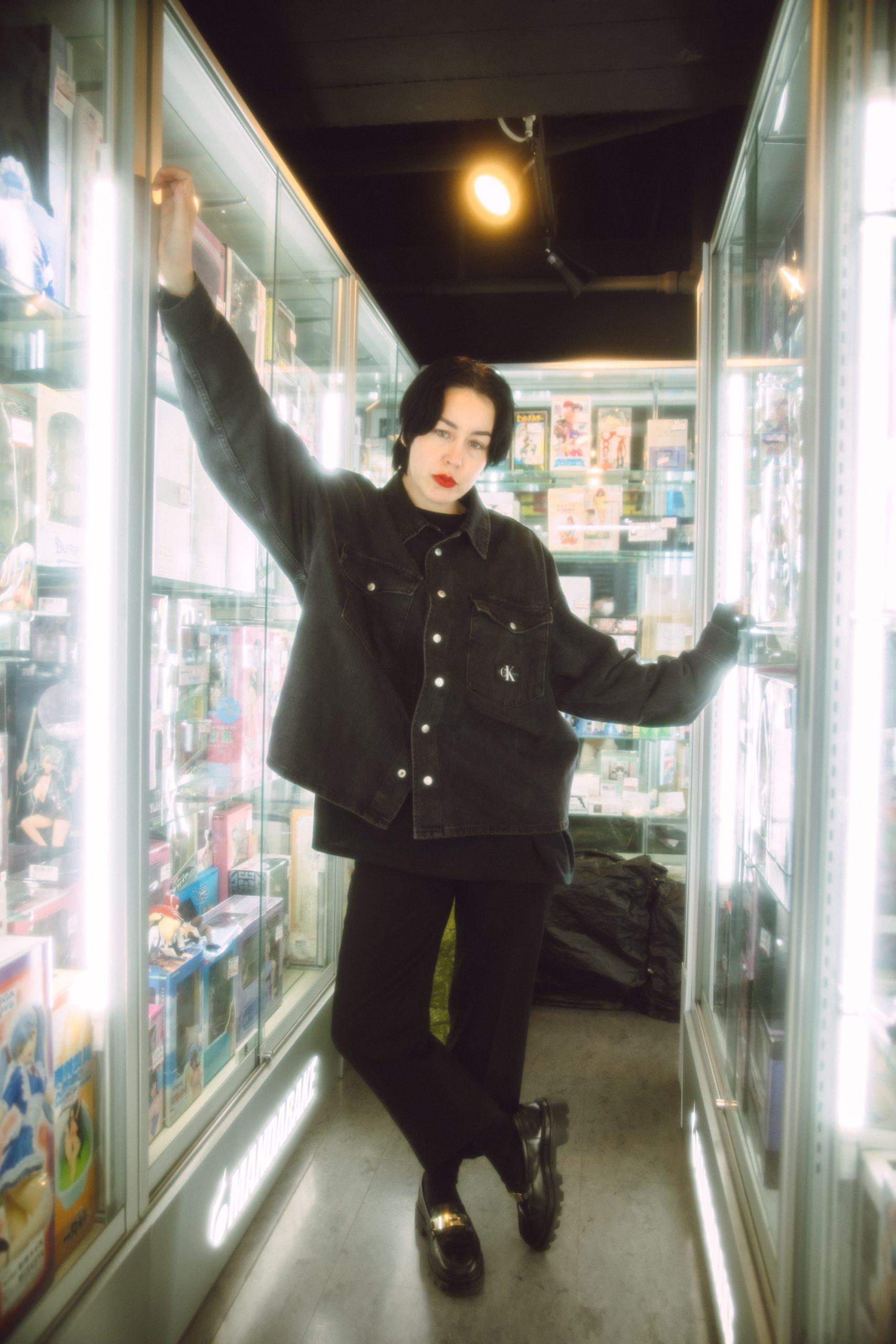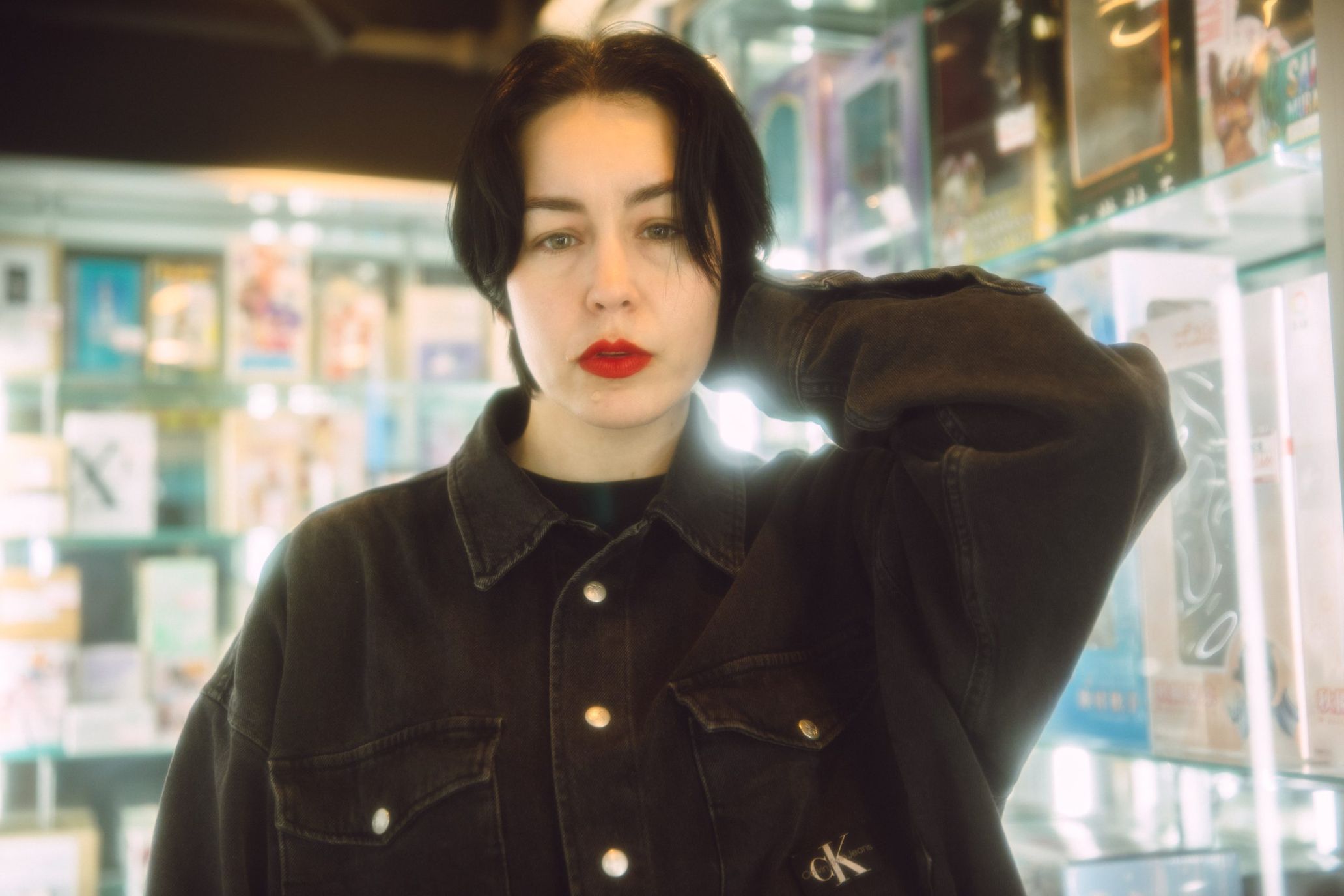
Bunny Bissoux
Bunny Bissoux is an artist, illustrator and writer. Their work explores recurring themes including pop culture, obsession, gender, queer identity, and consumerism through a variety of mediums, including their own collections and cultural research. After studying at Central St Martins and the University of Brighton they began a professional freelance career in 2007, also undertaking prop- making, set design and art direction. Bunny relocated to Tokyo, Japan in 2011. In additional to solo exhibitions at KATA gallery and WISH LESS, their commercial clients include Space Shower TV, Pony Canyon, Furyu, WEGO, MTV and Nylon Japan. Beginning in their teenage years and throughout their career they have continuously engaged in DIY self publishing, producing numerous zines and artists books with regular participation in international events Tokyo Art Book Fair and Unlimited Edition (Seoul Art Book Fair). In the UK Bunny has contributed several complex visual maps for the Home of Metal project celebrating the West Midlands (UK) region as the birthplace of heavy metal music. Currently active as an Artist-in-Residence for Grand Union x Bruntwood in Birmingham, UK until 2025.
Tokyo Art Book Fair 2023 (TABF) was held at the Museum of Contemporary Art Tokyo for four days last November. Since its inception in 2009, it has grown in scale each year to become one of the most popular art-related events that attracts tens of thousands of visitors. Artist and illustrator from England Bunny Bissoux has participated more than ten times in this event. Even if their name doesn’t ring a bell, those who have visited TABF will undoubtedly recognize their illustrations, with catchy and lively color hue and pop-style lettering, making an interesting contrast with figures with cool and somber expressions.
Having lived in Japan for 11 years, Bunny Bissoux is a genuine “otaku,” a lover of Japanese idols, K-POP, and pop culture. We at TOKION interviewed Bunny, who was back in Japan for TABF, in Nakano, their favorite neighborhood in Tokyo. Bunny says Japanese culture matches them better than British culture. We asked Bunny about their works, encounters with Japanese idols and K-pop, and their thoughts on love and desire for idols, the relationship between pop culture and gender, and the appropriate forms of derivative works.

Bunny’s interest in Japanese culture
— You came to Japan for the first time in a year and a half since you returned to your hometown in England last spring.
Bunny Bissoux(Bunny): I came here to exhibit at the “TOKYO ART BOOK FAIR,” and it has been very fulfilling to visit so many favourite places and meet many friends after a long time. From tomorrow, I will go to Sapporo where my older brother lives. He has been living in Japan for about 15 years now.
— So, was it your brother’s influence that got you interested in Japan?
Bunny: No, not at all. I fell in love with Japan when I was a teenager. it was “FRUITS” (a street snapshot magazine launched in 1997) that got me interested. There was an anthology book published by Phaidon in 2001, I was really fascinated by it. At that time online resources were mainly text based, there were no street snap blogs yet, so I went to a department store in London called Japan Centre and bought these expensive imported magazines that featured Japanese fashion and pop culture. and I was very attracted to the idol aesthetic. I knew I definitely wanted to visit Japan, and after a trip to Tokyo with my brother, my desire to live in Japan grew.
— So you immediately decided to move to Japan?
Bunny: Not until many years later, because there were a number of factors that prevented me from taking a big leap for a while, such as university, work, and my relationship with my partner at the time. But after all of that cleared up, I got a working-holiday visa in 2011 and came to Japan with the intention of staying for about a year first. I ended up staying for about 10 years after that.
–You must have been in the right boat, because you came to Japan for 10 years instead of 1 year. Did you feel uneasy when you started living in Japan?
Bunny: I am a freelance artist, so I hoped that I could continue my work in Japan. I studied Japanese for a year in a university evening class, but it wasn’t very practical and I realized I wasn’t very good at studying from a textbook. So I learned it by living and talking with people. However, my vocabulary and grammar are is not very good, and it is still difficult for me to express my feelings accurately in Japanese (the interview was conducted mainly in English).
–When you actually lived in Japan, did you find any gap between Japan and what you had imagined?
Bunny: Not so much at first. I had learned a lot about Japan through TV and movies, and even though I was in a strange place, I felt a strong affinity with it. I did have a problem with things like not knowing how to heat my room in the winter (laughs). In England, there is a central heater that heats the entire room. While there were those small gaps, there were no parts of the people’s behavior that surprised me at all. I think people from other countries tend to think of Tokyo as a futuristic city. But in reality, there are still very old-fashioned customs, such as having to go to the city office and fill out a lot of forms. But many things are more convenient and organized here. It wasn’t so hard for me.
— I think you and Japan must have been a good match.
Bunny: After living in Japan for 11 years, I returned to England last year and was struck by a kind of reverse culture shock. I was surprised by the behavior and culture of the British people. I am still having a hard time adjusting. I am neurodivergent and deaf in my right ear, but I was very comfortable while I was in Japan. Japanese people don’t interrupt people and talk over them, and everyone is polite and respectful. In contrast, in England, important things are sometimes communicated quickly and casually. I think that my personality is better suited to Japan, where people are more considerate about things. I really appreciate how people take care of their belongings here, and public spaces are clean and tidy
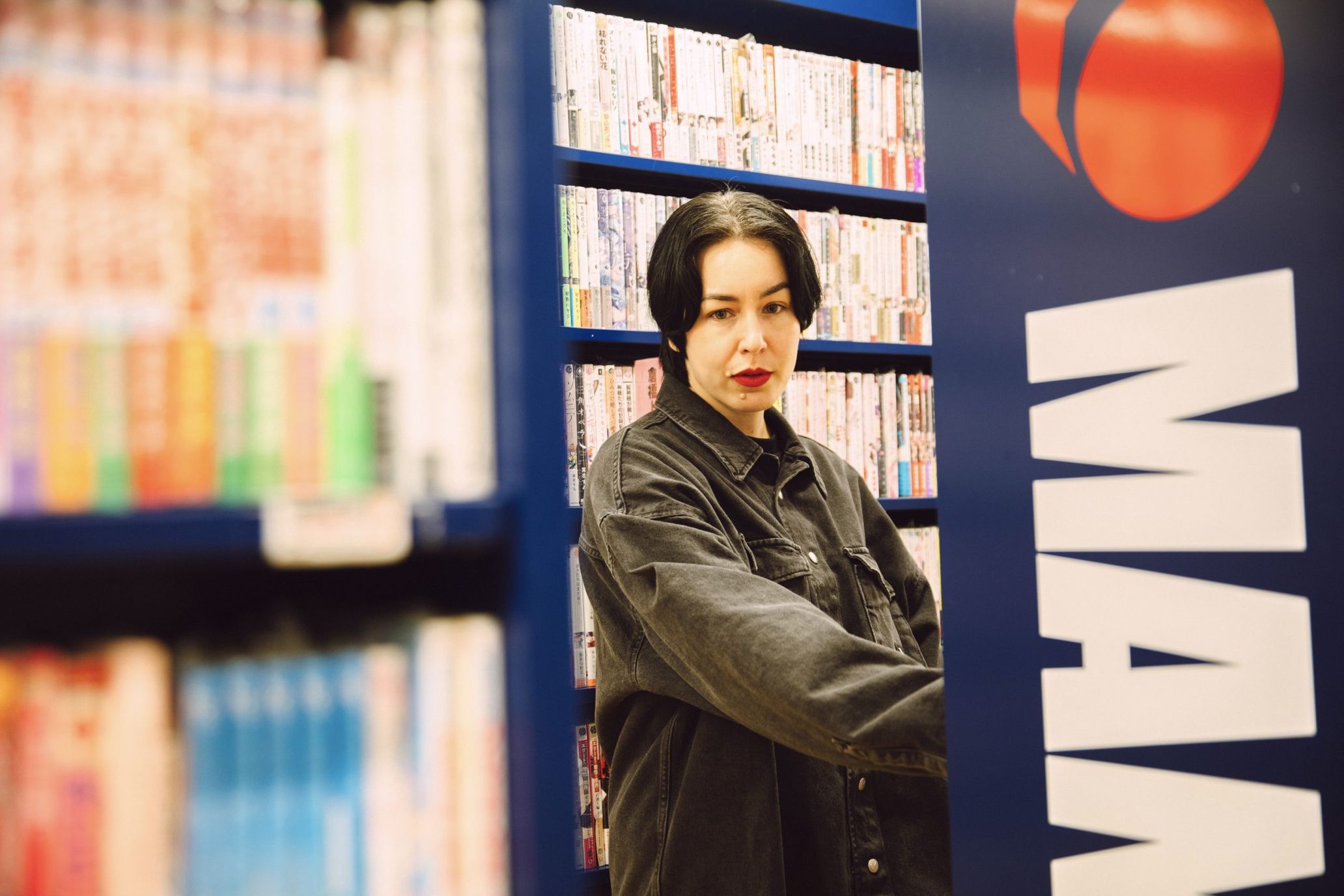
Encounters with Japanese Idols and K-Pop
–You are from Birmingham, England, the birthplace of heavy metal bands such as Black Sabbath and Judas Priest, aren’t you?
Bunny: Historically, the region is known for manufacturing and metal working, and it is said that Black Sabbath was inspired to write songs by the sounds of the factories. Even though Liverpool has many Beatles-related tourist attractions, sadly Birmingham doesn’t have a permanent place that celebrates this heavy metal and rock culture. I used to go to a lot of loud alternative shows when I was younger. I was especially active in going to watch American bands when they came on tour, mainly experimental punk and post hardcore music. I was fascinated by the energy that the band and audience gave off and the sense of connection between the two. I fell in love with idols at a time when my interest in the live music scene was slowly fading.
— What sparked your interest in idols?
Bunny: I became interested in Johnny’s when I was in England, a Japanese friend at university tried to introduce them to me, but I didn’t really understand the structure of them. My brother’s girlfriend was a casual Johnnys fan, so I asked him to teach me a little about it when I visited Japan. When we went to Takeshita-dori in Harajuku together, I was really fascinated by the repetitive and a kind of maximalist aesthetics, with the same kind of fancy goods and bromide photos placed repeatedly all over the idol stores. At the same time, it was also a personal world where you could choose your favourite things, write the number of them down yourself and buy them. I found that kind of culture fascinating in itself. But when I looked for Johnny’s-related footage after returning to England, I couldn’t find much on the Internet because of strict copyrights issues. On the other hand, I found a lot of K-pop content, so I got into SHINee around 2008 or 2009. I was immediately captivated by their synchronized dancing, catchy music, and flamboyant style.
— I know you also like EXO and NCT, so did SHINee lead you to dig more and more artists from SM Entertainment?
Bunny: Yes, SM has a very interesting concepts. I’ve seen a lot of artists from other agencies, but I’m still the most interested in SM’s creative production. When I saw the teaser video for EXO’s debut, I was so excited by the story that they were coming from another planet, it was so cinematic and fresh. I was instantly hooked. I’ve always loved Kai in particular, and the same goes for NCT, which I’ve been paying attention to since before their official debut. I’ve always supported idols as if I were investing in them. Now, K-pop is evolving as an industry, and we are consuming a lot of content and merchandise. Even though they are very commercial, I get great pleasure from it. I am interested in thinking about the idea of beauty and gender, masculinity and femininity, and K-pop sort of makes me think about those issues a lot. That’s another reason why I like K-pop.
The relationship between love for “favorites” and their own artwork
— I guess you have your “favorite” members in each group, but is there anything in common among the members that you like?
Bunny: Taeyong and Kai are very talented dancers and visually represent their groups. I am also attracted to the gap between how they look and how they truly are: they both have a very strong image (charismatic and confident), but inside they are soft and very sensitive. I, too, may have a strong appearance, but I am actually very introverted and sensitive. In that way, I may be projecting myself on them. But, well, I’ve been a fan for many years now, so it’s hard for me to talk about it objectively……. (laughs). Although they are much younger than me, I am inspired by watching them grow older and mature and take on various challenges.
— Bunny, you have produced a number of zines about idols, haven’t you? Do you express your love for idols in them?
Bunny: Actually, in my zines and my own works, I compile what I have researched about idol culture itself, rather than expressing my love for the idols. For example, for ‘Rolling Rolling’ my Hikaru Genji zine, I found their costumes and performances on TV programs very interesting during my research, and the fanaticism surrounding them, so I compiled my research into the zine. I think the idols I like are unconsciously influencing my expression of male beauty in my drawings, but I don’t express this in a direct way in my work. I think I express my affection for my idols in the same way as other fans, cherishing their music and content, by going to concerts, collecting goods, and so on.
— I see. So you draw a line between your practices as a fan and your expression as an artist.
Bunny: I don’t intentionally separate the two, but for me, the love I have for my favorite idols is so personal that I don’t feel comfortable expressing it as a work of art. Drawing the people I love is actually the hardest work to do. Technically, I can draw them, but Taeyong and Kai are the most beautiful people in the world for me, so I will never be satisfied with what I drew. Fans sometimes hand out fan art stickers and goods to each other, and I sometimes think about doing something like that, but because I am a professional artist, I still wonder if it is right thing for me to do… However, the Hikaru Genji zine and my H.O.T. zine “Teenager Forever” are works which mix my research with my own affections and taste.
— H.O.T. is a first generation K-Pop idol who debuted in 1996, right? In recent years, NCT DREAM covered their song “CANDY” and it became a hit.
Bunny: Although I did not know them when they were active, I was very interested in their hairstyles and costumes of the time, it was an era when street fashion in Korea was becoming strongly influenced by a mix of foreign styles like American hip hop and Japanese visual Kei, so I created this zine as a compilation of my research results. I drew the evolution of their performances in chronological order, and I also included URLs through which you can actually watch the videos. I inserted shiny film papers in between the pages, because I wanted to make something tactile with a sensory reading experience.
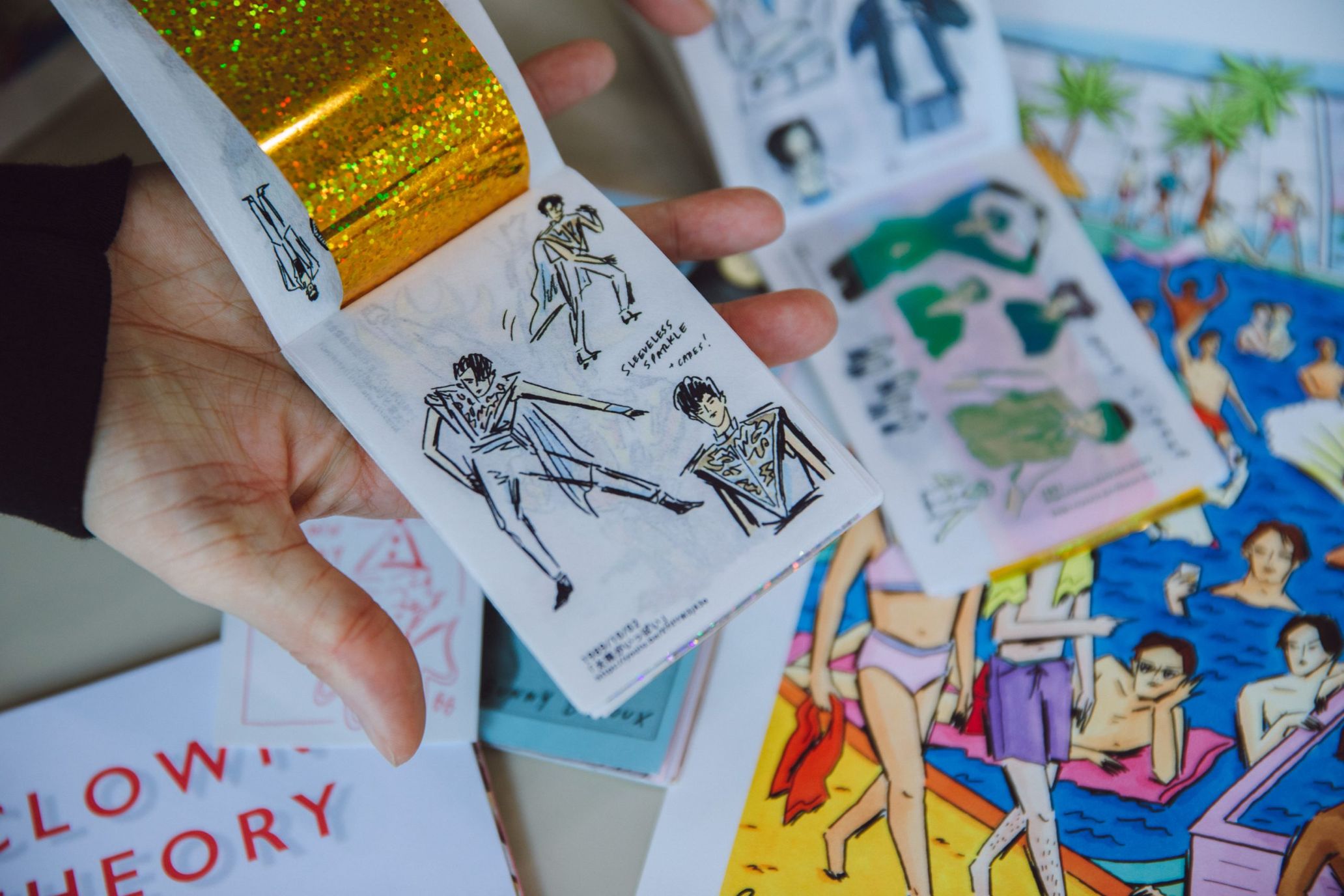
“Oshikatsu,” desire, and derivative works
–That is very playful. By the way, “oshikatsu” is now an unprecedented boom in Japan, have you heard of the term?
Bunny: I have vaguely heard of it.
— The act of showing affection for the ones they love, which are not limited to idols but also include characters and actors, though collecting goods and participating in events is booming. Not long ago in Japan, being an otaku was something to be ridiculed, but nowadays, people all over the place call themselves otaku. Personally, I think it is like having a little god living inside of you, like a talisman that gives you vitality in life. I would like to hear how you feel about this kind of oshikatsu boom.
Bunny: Idol culture is still difficult for people in the West to understand, they often misinterpret it as only a musical genre. For me, idols are different from regular musicians or pop stars, there is a fantasy of something beyond regular human beings. But I feel that supporting idols has a lot in common with how sports fans are supporting their favorite team. Sports fans also wear the uniforms of their favorite teams and buy merchandise, they follow rookie players as their careers unfold, they gather together for events and scream and cry. To me, that is no different from idol fans, but in the West especially, idol culture is placed lower in the hierarchy. This may have something to do with the fact that sports are often associated with masculinity and idol culture with femininity. I think there is certainly a religious and ritualistic element to oshikatsu. Because I get joy and motivation from it. I usually feel like I am an alien. I don’t really feel connected to other human beings. But when I go to concerts of my favorite idols, I get a great sense of being connected to other human beings. There is a sense of sharing something.
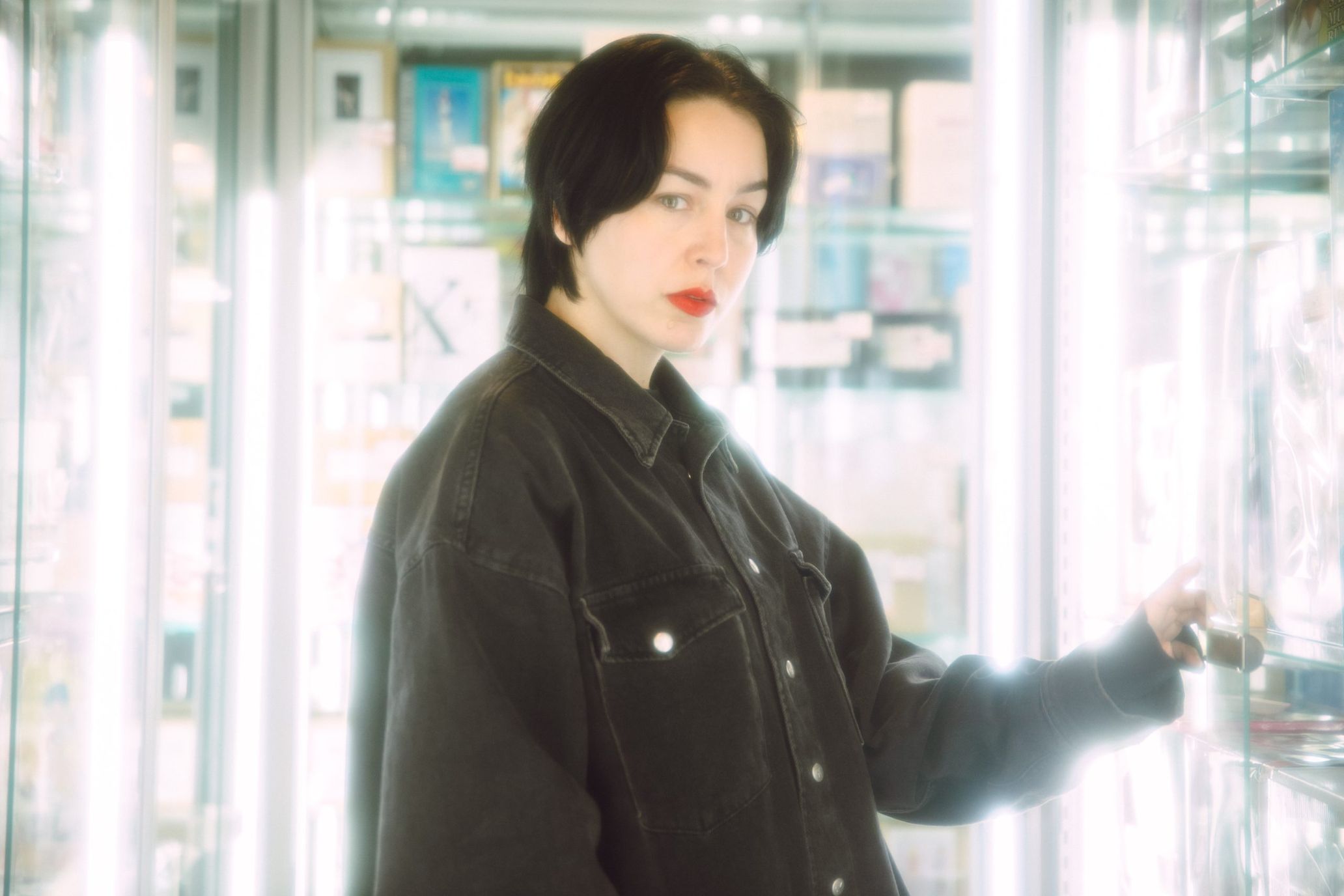
— So your favorite idols function as an intermediary to connect you with the world. By the way, some people feel guilty about looking at idols of the opposite sex as objects of desire. Is there any case that you feel the same way?
Bunny: First of all, I think that desire is misunderstood. Everyone has sexual desires and non-sexual/ platonic desires, and it is natural to have fantasies involving other people (celebrities or not). And I don’t think it is wrong to acknowledge this. I am non-binary, and for me, idols are also objects of my fantasies regarding gender, what I want to be like and look like. Whether I am sexually attracted to them or have a platonic longing for them, or want to imagine looking like them is complex and ambiguous. As a queer person, I think I am probably more comfortable with this ambiguity. However, of course I think there is also a dark side to the feeling of attraction or objectification for your own pleasure. Recently, things like deep fake porn are worrying.
–Deep fake is the use of AI to process a portion of an image. There have been problems with fake porno images of celebrities in which their faces have been merged with naked body image.
Bunny: To present something fake as reality, I think it is very much a disrespectful act, and I think it is irresponsible and dangerous to distribute such images on the internet, because it’s very difficult to control them once they are circulated. On the other hand, fan made works which are clearly fictional and not presented as reality, such as ‘fan fiction’ stories or doujinshi manga containing sexual elements, I do not think it is wrong. If you want to publish this kind of work, you need to be careful about how and where you present it, especially if it involves real people. But I don’t think it’s wrong to have desires, indulge your imagination, and create fantasies. I believe exploring and expressing our fantasies and desires gives us freedom to explore and express things that might not be possible in our everyday lives, whether that is gender & sexuality, fetish, romance, or something else completely.

— Thank you very much for sharing your interesting stories. By the way, what is in your newest zine “CLOWN THEORY” that you presented at the “TOKYO ART BOOK FAIR” this time?
Bunny: The theme is sad clowns. For some reason, I have been irresistibly attracted to clowns since I returned to England. This book is a compilation of my research on them. For example, one chapter is dedicated to clowns sold in charity (recycle) shops. Why were these clowns bought and sold? Why is it no longer needed? I am considering these things through essays, articles, photographs and illustration. Also, there are a lot of clown memes used by online fandoms. I traced when and how that expression became visible chronologically and highlighted its connection to K-POP fans. Incidentally, Key from SHINee became an icon of clown memes with his 2015 Halloween costume of Ronald McDonald, which became prolific even outside of K-pop fans. Finally this year he appeared in a McDonald’s commercial! When I started to see these connections, I really enjoyed it.
–So your creative style is all about thoroughly researching and compiling your findings and thoughts.
Bunny: I research what I like and find interesting, interpret and process this input, and then create my own expression of it. The truth is, I don’t really like clowns that much (laughs). But it is very interesting to find these connections between history, pop culture and humanity.


Photography Miyu Terasawa
Translation / Edit Shinichiro Sato(TOKION)



